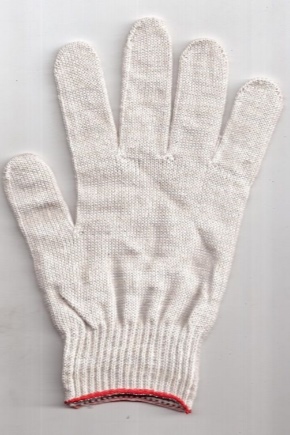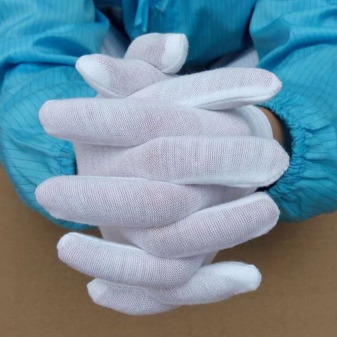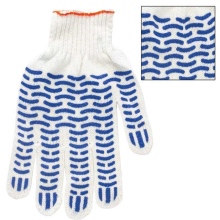All About Cotton Gloves

Among all the varieties of gloves existing on the modern market, cotton models are especially popular and in demand among consumers. Today in our article we will talk in more detail about the characteristics of this product.

Description
At their core, cotton gloves are personal protective equipment. They are used in order to protect hands from all kinds of injuries, as well as to make work more convenient, comfortable and safe. Most often, this means of protection is worn in the process of performing various kinds of work, for example, in such areas of human life as:
- metallurgy;
- loading and unloading works;
- oil and gas industry;
- agricultural work;
- car service and many others. dr.
In order for gloves to be of the highest quality and perform all their functions, they must comply with a number of standards.
So, the detailed characteristics of cotton gloves are detailed in the corresponding GOST.


Advantages and disadvantages
Like any other gloves, cotton varieties have a unique set of their distinctive characteristics. Moreover, such properties are both positive and negative. Accordingly, before purchasing a product, you should familiarize yourself in detail with all the pros and cons.
Let's start by looking at the benefits of cotton gloves.


Reliability and safety
As mentioned above, gloves are a means of protection. Thus, carrying out this or that work not with bare hands, but with gloves, you can protect yourself from various types of mechanical damage (for example, abrasions or scratches). Besides, Gloves prevent calluses and also provide a high level of grip.


Hygiene
When doing so-called dirty work (for example, in the field of agriculture or when loading goods) with gloves, you can avoid direct skin contact with all kinds of dust and dirt.


Hypoallergenic
Due to the fact that (to a greater extent) natural raw materials are used in the manufacture of this type of gloves, the user does not experience allergic reactions, rash, itching and other negative consequences do not appear.


Comfort
Unlike some other types of personal protective equipment, cotton gloves are lightweight - the user practically does not feel them in his hands, they do not cause discomfort or discomfort. Besides, there is no need to worry about arranging a special place for storing PPE.
Gloves can be kept in a dry room at room temperature.


Environmental friendliness
Gloves (like many other goods) have their own shelf life - over time they wear out, break through, lose their integrity and, as a result, cannot be used for their intended purpose. When your cotton gloves have become unusable, you can throw them away without a twinge of conscience. The thing is that, thanks to the natural material of manufacture, when decomposing, they do not harm the environment, do not emit harmful substances into the atmosphere.


Availability
In this regard, we mean both affordability (cotton gloves are quite inexpensive, so almost everyone can buy them), and high prevalence (the product can be found in almost any hardware or hardware store).
But, in addition to the advantages, some disadvantages should be highlighted. Most often, users say that cotton gloves deteriorate rather quickly and have a short shelf life (for example, when performing especially difficult work, gloves become unusable after the first use).
Thus, it can be concluded that the advantages of cotton gloves significantly outweigh their disadvantages, which explains the great popularity of this personal protective equipment.


Varieties
Due to the high prevalence of cotton gloves on the modern market, you can find several varieties of such goods (for example: insulated, working, thin, knitted, white, black, double winter, without and with PVC, etc.). In general, depending on certain factors, personal protective equipment is divided into several main categories.

Main classes
First of all, it is important to consider the existing classes of cotton PPE.
- 7 (or 7.5) class. Gloves that fall into this category are characterized by a standard knit density. Of all the existing models, these models are the thickest and roughest. Among the main advantages is the fact that this particular variety will best protect your hands from mechanical damage.
- Grade 10. In gloves of this type, the threads fit more tightly, but at the same time they themselves are quite thin. Most often, this type is used in production during painstaking work (for example, repair or assembly of products). Hands in such gloves maintain a high level of sensitivity.
- Grade 13. The knitting density of these gloves is 4 times higher than that of the 7th class. Despite the fact that PPE is quite thin, it is very tight. This type is recommended for performing tasks that require high precision.
Thus, in the process of choosing a particular class of gloves, first of all, you need to focus on the nature of the work that you will perform when using this PPE.



Types of drawing
In addition to the class, the most important characteristic of cotton gloves is the type of pattern. There are several varieties.

Drawing "Point"
If this pattern is applied to the gloves, then they should be chosen for performing light and medium jobs. So, this type will be relevant in the course of performing various kinds of repair tasks or for loading various objects.

Drawings "Herringbone", "Brick", "Protector" and "Wave"
These gloves are suitable for tough jobs. This is due to the fact that, thanks to the printed pattern, the PPE provides a high level of grip reliability (which is especially important if you are moving heavy loads).
Thus, we can conclude that the purchase of gloves must be approached carefully, because there are a large number of different models, each of which is designed to perform certain tasks.



How to choose and use correctly?
Choosing gloves is an important and responsible task that must be taken as seriously as possible. Wherein experts recommend paying attention to several key factors.

Thread density
This characteristic is measured in grams per kilometer. In this respect you should choose products whose thread density is quite high, as this guarantees a high level of strength and a long period of use.
- Density. In this regard, it is meant how warm the gloves are and whether they are suitable for working in cold weather. In some situations, this characteristic is key.
- Overlock. Some manufacturers, in an effort to prevent the cuff from spreading, make an overlock at the end of the cuff. Thus, they extend the shelf life of the product. If there is no overlock, then there is a high probability that the threads will unravel on the cuff, which will not only negatively affect the appearance of the gloves themselves, but can also lead to all sorts of negative consequences (for example, injuries).
- Price. As mentioned above, cotton PPE is fairly affordable. However, different manufacturers charge different prices for the product. You should focus on the best value for money.
Thus, taking into account all these parameters, you will purchase a quality product that will serve you for a long period of time.
Once you've chosen and purchased your gloves, it's important to use them correctly. So, in any case, do not ignore the recommendations of experts and the characteristics of the gloves. Thus, it is forbidden to use gloves designed for high-precision work to carry out loading (and vice versa). This can lead to injuries, poor quality work results and other undesirable consequences.
In addition, after use, it is recommended that PPE is thoroughly washed, dried and stored in an appropriate storage location.
This will contribute to the long-term use of the product.

How to choose the right cotton gloves, see the video.













The comment was sent successfully.